Step into the enchanting world of Montessori homeschooling, where learning becomes an adventure for young minds. Picture children immersed in play, uncovering educational mysteries through their interactions with Montessori materials. The Montessori homeschooling method effortlessly bridges the gap between abstract concepts and tangible experiences, igniting a fire of curiosity within each child. This educational approach is a gem – especially for younger students.
In this article, we’ll be discussing:
- Who was Maria Montessori and What is the Basis of the this Method
- Benefits and Advantages of the Montessori Method
- How the Montessori Method Differs from Traditional and Waldorf Education
- Order, Concentration, Coordination, and Independence: Foundational Skills
- How Do I Help My Child to Become Independent?
- Criticism of Montessori Education
- What were Maria’s Religious Beliefs and Are these Schools Christian?
- What Does the Research Say About the Effectiveness of a Montessori Education?
(If you want to find out how to set up a Montessori home environment, see this link.)
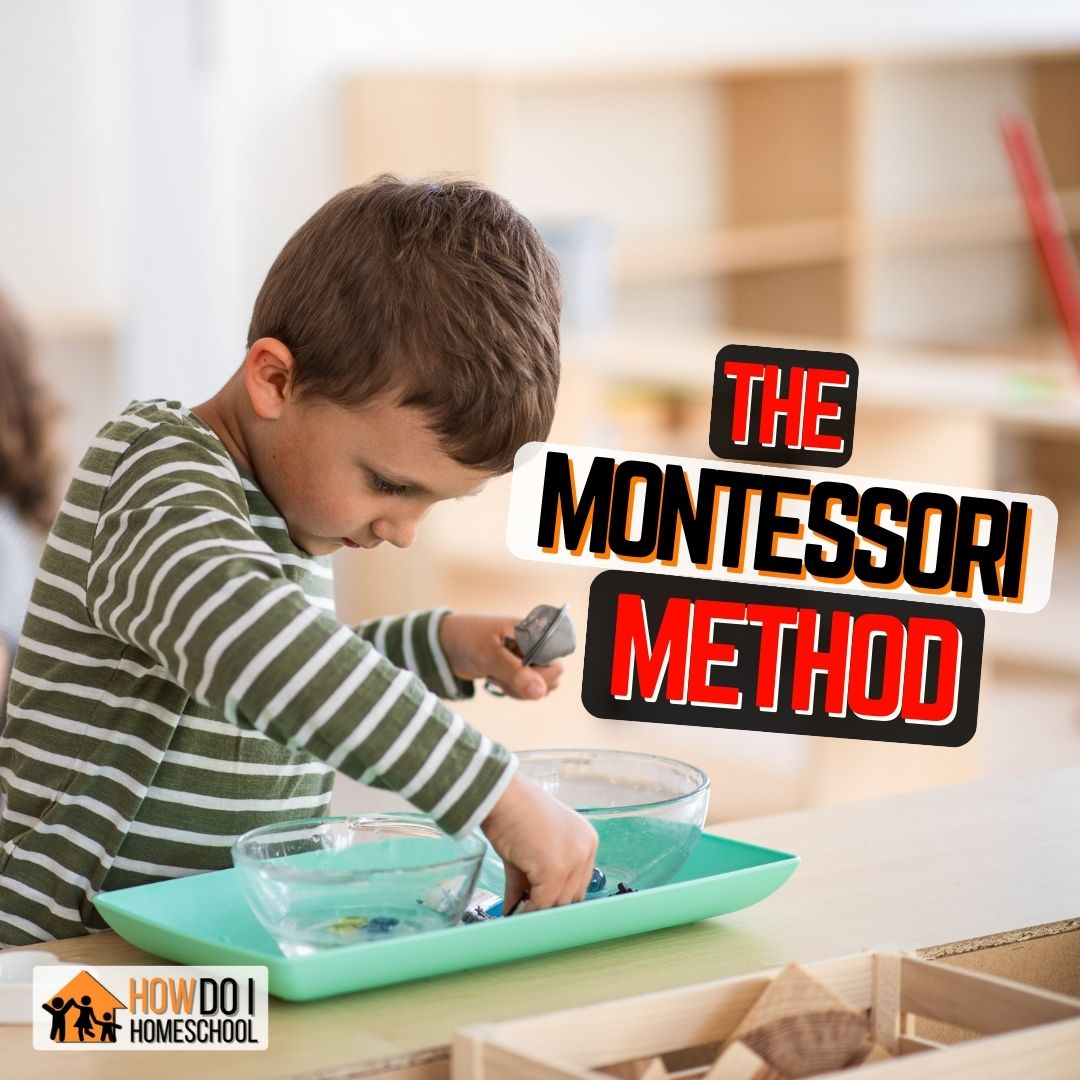
Some of the links in this post are affiliate links.
Who is Maria Montessori
Maria Montessori was an Italian educator and medical physician who developed a unique way to educate children using more hands-on, independent educational ways.
Maria was born in the small town of Chiaravalle (Italy) in 1870.
Her mother came from a family that loved education, so Maria was taught well and developed a love of reading which was an unusual thing for an Italian woman in the 1800s.
What was more unusual was that Maria would soon start studying engineering after attending a technical, all-boys school.
However, she changed her mind and (after being rejected once) entered into a medical degree – a field of study that men completely dominated.
When she graduated, she was one of the first female doctors in Italy.
After her medical training, Maria focused on psychiatry and learned much about educational theory and pedagogy.
However, her learning made her question traditional educational methods and wonder if things could not be done in a better way.
Maria started working with special education students and performed teaching experiments, observing what the children responded to more.
After a while, Maria opened a childcare facility in a poor inner-city area.
This was a huge success and the news of this spread worldwide, leading to the opening of many Montessori schools. Today there are over 20,000 of these schools worldwide.
Benefits of the Montessori Method (Pros of Montessori Education)
Some of the benefits of Montessori education include:
- Children can study what interests them at their own pace. They are not hurried (or slowed) to fit into the model that is considered ‘normal’ in schools.
- Montessori education will seek to help children according to the educational method they learn best with – this accommodates their learning styles.
- Children can have physical freedom to move around the room.
- Montessori values diversity. Sometimes parents from different cultural backgrounds will talk about their country, and children can sample foods from that region. This may include dressing up for the theme also!
- Children grow up in a multi-span classroom (of three years) and have the same teacher during that time.
- Learning is collaborative between the teacher and student, instead of only teacher-led. This makes room for interest-based learning.
- Montessori students are encouraged to teach themselves and follow the rules. This also means there are no tests, exams or quizzes.
Perhaps these benefits are best summed up by saying children are taught order, coordination, cooperation, and independence – traits that are foundational Montessori skills.
We will look at these skills in more detail further down the page.
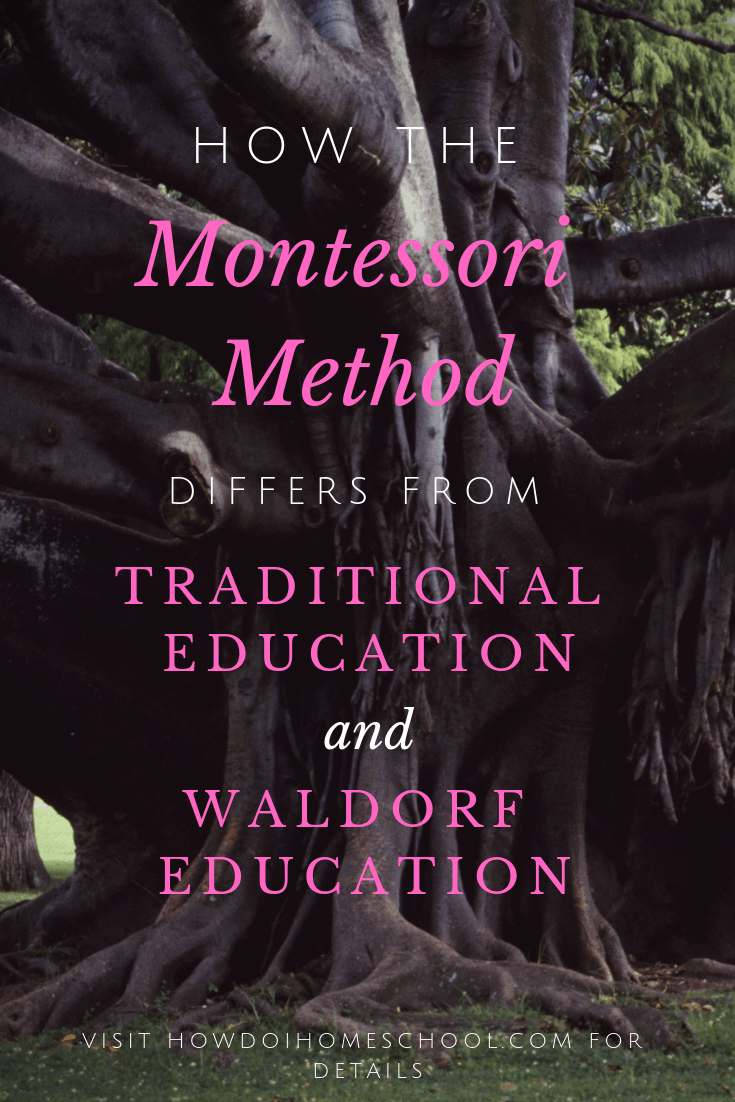
Differences Between Traditional vs Montessori Methods
Some key differences between Montessori and traditional education include:
- a focus on holistic living skills (academic, social, practical, and life skills) and academics (traditional schools focus more on academics).
- mixed-age group. Usually, a Montessori classroom has children whose ages span across three years (classes are usually grouped in the following age groups: 0–3, 3-6, 6–9, 9–12, 12–15, and 15–18 – although classrooms in the preschool ages are most common by far). In comparison, traditional classrooms segregate children every year.
- teachers who are mentors over a series of years. This approach allows a closer bond with teachers as they follow students through three years instead of one.
- freedom to move around the room. Montessori schools allow students to move and talk when they want to, so long as they’re not disturbing others. This is different from traditional education, where children are assigned spots to sit and usually can’t talk at all.
- children can work at their own pace and are not forced to move on to other activities after a short time (Montessori schools allow three-hour blocks, whereas traditional schools typically only allow one).
- an emphasis on being independent. This means children teach themselves, whereas, in traditional education, students are taught by teachers who follow a national curriculum.
- children being active participants in learning (as opposed to traditional schools where they are more passive participants in learning)
- teachers who collaborate in learning with children. Traditional classrooms are led by teachers who lead the learning, and the children follow.
- less competitive classrooms. The Montessori theory says children will get their own motivation and reward from their development. A traditional classroom metes out rewards and punishments as a means of motivation.
- children are encouraged to self-discipline. In a traditional classroom, the teacher enforces external discipline.
Much of this can be summed up by the Montessori principles of order, concentration, coordination, and independence.
We’ll talk about these principles later.
Differences Between Waldorf vs. Montessori Methods
Some key differences between the Montessori theory of education compared to a Waldorf education include:
- a focus on fantasy and imagination. A Waldorf school will focus on real-life experience. For example, in a Montessori school, a child might use a grater to grate soap into a bowl. Then they would beat the grated soap (plus water) into suds and dispose of the concoction in the toilet when they’re finished. A Waldorf school, however, would encourage the grating of carrots or cheese in preparation for the lunch meal, which they will all sit down and enjoy at lunch (therefore, Waldorf tries to connect learning with real-life more).
- shorter age groupings. Whereas the Montessori theory encourages groupings over three years, the Waldorf method groups children over three cycles of seven-year stages. In both types of education, children have the same teacher over their period. This means children will be with a Montessori teacher for three years and a Waldorf teacher for seven years.
- focusing on some subjects long before Waldorf schools. The Montessori method teaches children concepts very early, and they go through spiral learning, revisiting the subject in more detail later on. A Waldorf education, on the other hand, specifically omits teaching many subjects like reading as, they believe, fostering imagination earlier will lead to a desire for these subjects later – and it won’t burn children out too quickly.
- a clean layout that’s very simple. In comparison, a Waldorf school is more ‘earthy’ in that there is a very big connection with the outside and with doing activities that correspond with real life (like baking bread and building with blocks).
Many parents toss-up between a choice of Waldorf or Montessori education. And indeed, it seems there are quite a few similarities and values between the two methods.
Order, Concentration, Coordination, and Independence: Foundational Montessori Method Skills
When you’re researching the Montessori theory, you’ll find the words ‘order, concentration, coordination, and independence‘ (OCCI) repeated repeatedly.
This is because these proficiencies help with basic life skills this type of education aims to teach.
To look at why OCCI is so encouraged, see below:
- Order – order is encouraged in the Montessori method as parents want to teach children to be methodical and organized. This is taught through activities like sorting or pouring. They also see order in action when parents meticulously plan out the room and pay attention to every detail. Rules and routines in a Montessori education also assist with creating order.
- Concentration – the Montessori theory says that improving concentration is good for learning. A Montessori home will also assist parents in improving children’s concentration when rules are in place and activities are repeated. Every time a child returns to an activity, they have an opportunity to concentrate on the task again and gain a richer understanding of the concept the material is trying to represent.
- Coordination – the Montessori theory is also big on teaching children finer motor skills like pouring or transferring things with spoons. Through practice, a well-designed house or school will provide plenty of opportunities to refine their clunky motor movements.
- Independence – while rules are important, the Montessori method also promotes independence in children. A well-setup-house should aim to increase children’s skills so they can start doing things themselves more as they grow. This makes a Montessori education different from a lot of other homeschooling methods. This is because Montessori children think it’s good to be independent and they have everything they need to succeed – they just need to find out how.
How Do I Help My Montessori Child to Become Independent?
At the heart of Montessori’s philosophy is independence.
Encouraging children to become independent and learn life skills (besides academics) is crucial.
But how do we encourage our children to become independent?
The following suggestions from the Montessori method help us encourage independence in children:
- Give them choices of activities.
- Use small baskets and trays they can carry with both their hands.
- Get child-size cleaning equipment (a mop, broom, and cloth) that they can use to clean up their mess…and encourage them to clean up all their messes.
- Let them set the [child-size] table and do things themselves as far as possible. Their morning or afternoon snack time is a great time to do this.
Sometimes teaching children to be independent takes time and seems like a huge chore to parents who can do the activity in seconds.
However, investing in making our children independent pays dividends in the future by making them more capable earlier.
It also gives them an exhilarating feeling of achievement and eventually means less work for parents.
Independence Comes With Responsibility: Montessori Classroom Rules
Although some parents might say Montessori classrooms are places where ‘children can do whatever they like’, Montessori classrooms have plenty of rules such as:
- When you have finished with an activity, leave it ready for the next person to do
- Do your activities on a rug
- After you’ve finished with your chair, push it in behind you
- Ask permission from another child if you want to join him in his activity (and wait for a positive response)
- Wash your hands before and after handling food, and after going to the toilet or blowing your nose
- Use two hands to carry things around the room
- Don’t run – instead, walk slowly and speak softly
Even teachers have lots of rules they have to follow. In this way, the teacher is an example and mentor for students to copy.
You can see a fuller list of Montessori rules here.
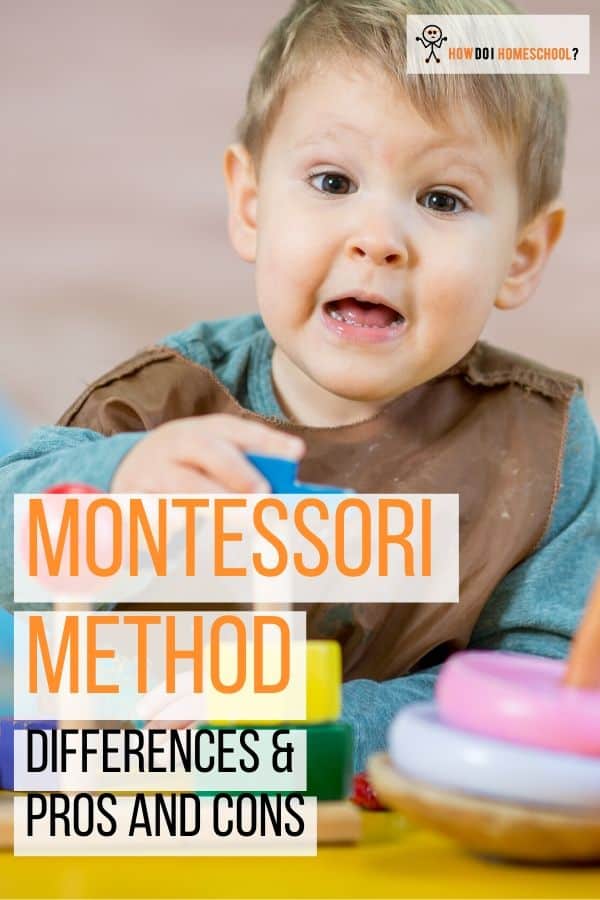
Criticisms of Montessori Education
Some criticisms of the Montessori method that are worth reviewing are:
- Too Much Freedom
- Not Enough Discipline
- The Montessori Method Doesn’t Include Grades, Homework, or Textbooks
We’ll look at these individually below.
Too Much Freedom
Critics of the Montessori theory say children are allowed too much freedom and independence. Some may interpret this to mean the Montessori theory encourages children to ‘do whatever they like’.
However, proponents of this type of education counter this by saying that, while children are allowed the freedom to do what they want in the classroom, the things they are allowed to do have been carefully selected for them. So, the child is making a closed choice that has been well-thought-out by an adult.
Not Enough Discipline
At the heart of Montessori philosophy is self-regulation. Montessori believed children can get to the point where they don’t really need discipline because they can learn to discipline themselves (self-discipline). The Age of Montessori describes self-regulation like this:
It is the ability to identify and modulate emotions, control impulses, delay gratification, make thoughtful, and conscience choices, and set goals and achieve them…Self-regulation is not an arriving point in children’s development, but a journey. It is one of the most vital skills for children to master in order to be successful in learning and in life.
As a fairly impartial observer who has looked at a number of articles on this topic, I wonder if this is a fair criticism to level. However, I would love to hear the other side from any Montessori teachers in the comments.
The Montessori Method Doesn’t Include Grades, Homework, or Textbooks
Yes, this is absolutely true! An integral part of Montessori beliefs is that students take ownership of their own learning. They aren’t forced to regurgitate facts for tests.
Instead, they’re allowed to take their time studying things that interest them (within a closed choice of materials). As far as many people are concerned (myself included), this is a huge pro of Montessori learning.
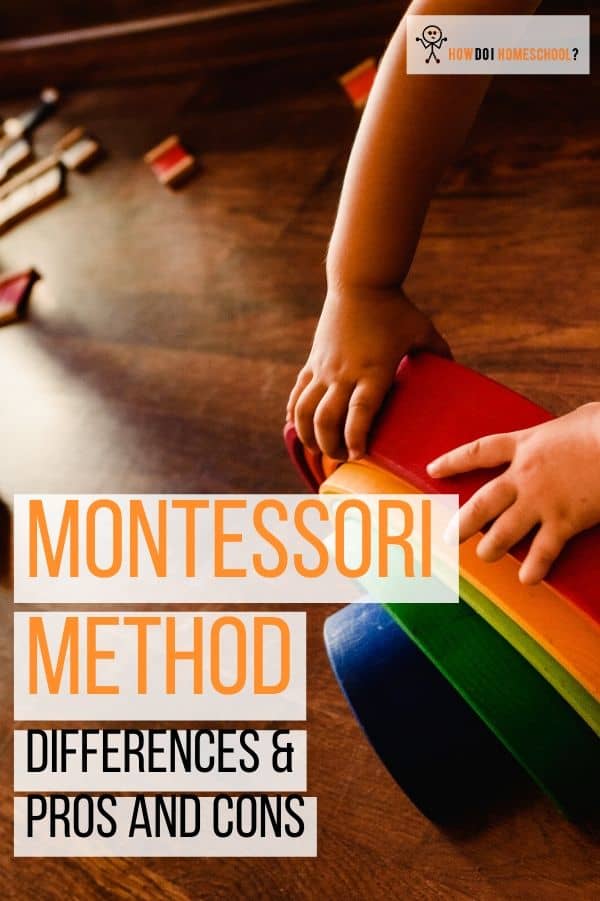
What were Maria Montessori’s Religious Beliefs, and Are Montessori Schools Christian?
When reading through some Montessori articles, I came across the following quote:
The universe is an imposing reality and an answer to all questions. We shall walk together on this path of life, for all things are part of the universe and are connected with each other to form one whole unity. [Montessori AMI]
This quote made me question whether
- Maria Montessori was a Christian and
- how religious Montessori schools are.
So what were Montessori’s beliefs?
Maria Montessori was born and raised a Catholic in Italy (a very Catholic country). However, Maria also spent some time in India learning about Indian philosophy. One article said this about her Indian experience:
Dr. Montessori actually spent time in India and the influence of Indian philosophy on her thoughts seems to be clear in her belief that we should not assume we know what children need and observe them instead. Be present, observe, and keep your own assumptions and ego out of it. That’s a pretty Hindu perspective.
We can also see Catholic influences in the Montessori method, such as when Maria refers to the evaporation of water molecules as angels carrying the droplets up to heaven.
However, the conclusion that seemed to be drawn from many articles was that Montessori philosophy isn’t particularly religious.
Debi Miller from Ministry Matters had this to say about it:
Many people think Montessori is a religious education. This is not necessarily true. Dr. Montessori was a devout Catholic, though she knew if she put Christianity into her education philosophy, children around the world may not be able to take part. She decided to ask Sofia Cavalletti and Gianna Gobbi to take over the religious arm of Montessori Education. They developed “The Catechesis of the Good Shepherd,” a Montessori philosophy based Christian education program. Some Montessori schools choose to be non-secular, while others use the Catechesis in their traditional program.
So, What is The Catechesis of the Good Shepherd
I did a bit of research into The Catechesis of the Good Shepherd and discovered its symbolism is very reminiscent of that in a Catholic church.
As a Protestant Christian, I feel extremely uncomfortable with the catechesis as it has many religious traditions surrounding it and some peculiar man-made traditions of the Catholic church.
Here are some quotes from one of the Catechesis websites which many Protestants would find concerning:
The atrium is a place in which the only Teacher is Christ; both children and adults place themselves in a listening stance before his Word and seek to penetrate the mystery of the liturgical celebration.
These themes are taken from the Bible and the liturgy (prayers and sacraments) as the fundamental sources for creating and sustaining Christian life at every developmental stage and, in particular, for illuminating and nourishing the child in his/her most vital religious needs.
… and prepares an environment called the atrium, which aids the development of the religious life. The atrium is a community in which children and adults live together a religious experience which facilitates participation in the wider community of the family, the church and other social spheres.
At the annual announcement of the celebration of first communion, the children respond according to the desire for the sacrament and their personal maturity, which is discerned with the help of the family, the catechists and the priest.
The Catechesis of the Good Shepherd offers its services to the diocese and therefore works in communion with the bishop…Every atrium avails itself of the help of a priest who is attentive to the children, particularly to their religious capacities, celebrates eucharist and sacrament of reconciliation with them, and works in harmony with the spirit of the Catechesis of the Good Shepherd.
(The first draft of these points was done by the Rome Association, May, 1993. They were offered for review to the first International Symposium, October 1994, in Rome. Amendments were proposed at a meeting in Rome, March 30, 1995. The points were then revised by the International Council, October, 1996.)
Protestants generally reject many of the sacraments the Catholic church upholds as traditions. They do this as they believe the Church has added tradition (and experience) to the Bible and therefore heaped unnecessary burdens on the laity (Matt 23:4).
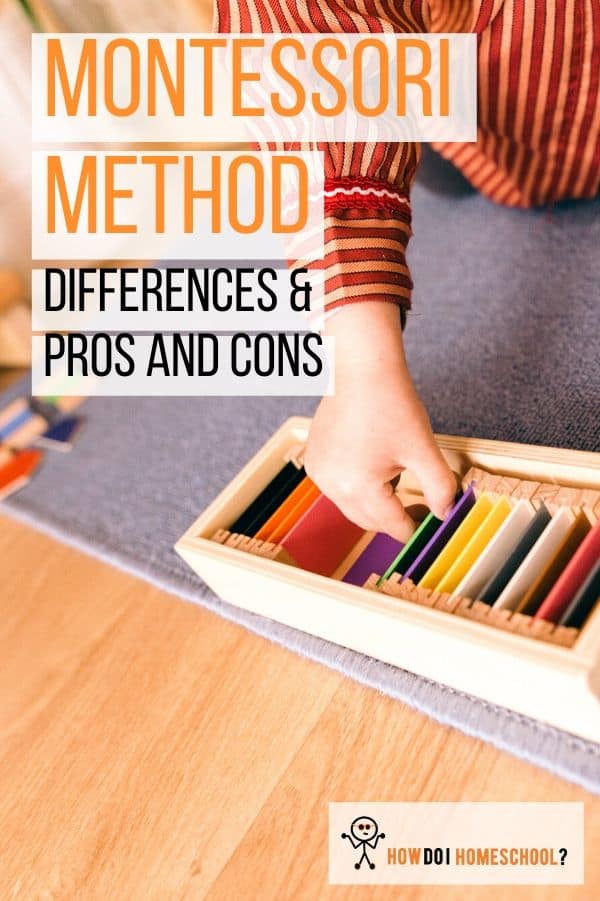
What Does the Montessori Research Say About the Effectiveness of a Montessori Education?
Research isn’t conclusive as to the effects of a Montessori education.
But perhaps this is partly because researchers find it hard to account for all the variables in a Montessori school.
While some studies say this method of education will help children in their schooling further down the track, others don’t find any indication of this.
Also, many schools masquerade as ‘Montessori schools’ even though they don’t strictly follow pure Montessori philosophy. This makes it difficult to judge the effectiveness of these schools.
Subscribe to How to Homeschool (my Youtube channel!)
Have you caught the homeschooling bug?
Eager to delve deeper into the realm of unconventional education?
Well, my curious comrades, rejoice!
There are splendid avenues awaiting your exploration.
Firstly, hop on over to my YouTube channel, where a treasure trove of homeschooling wisdom awaits. From practical tips to delightful anecdotes, I unravel the mysteries of homeschooling with a touch of wit and wisdom.
Subscribe, hit that notification bell, and embark on an enlightening journey with me.
Enroll in the Homeschool Parenting Program
For those yearning for a comprehensive guide to homeschooling, look no further than my Homeschool Parenting Program.
This online course will equip you with the knowledge, strategies, and confidence to navigate the exhilarating world of homeschooling like a seasoned pro.
Enroll today and unlock the door to extraordinary educational possibilities.
Conclusion
Although many of us can point to a few things in the Montessori method that we’re not too keen on, there are many things in a Montessori education that would impress any parent. In particular, I love that the theory promotes order, concentration, coordination, and independence – foundational Montessori skills. I also love that children can choose activities that interest them and so they are more engaged compared to a traditional school. Although I don’t know if I’ll be setting up a complete Montessori homeschool, I have definitely been inspired to use some elements of Maria’s theory!
The post Montessori Homeschooling Method 101: Hands-On Primary Education appeared first on How Do I Homeschool?.
